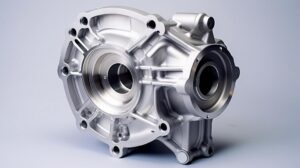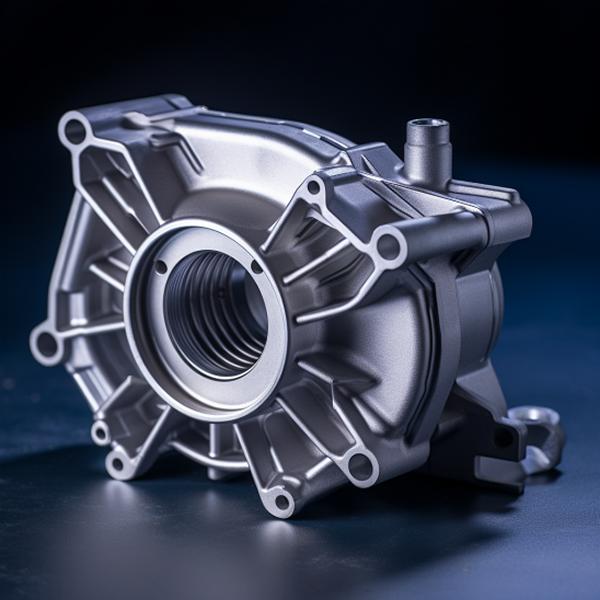In today’s fast-paced manufacturing world, the search for innovative and efficient production techniques has led to the rise of semi-solid metal die casting. This cutting-edge method represents a significant advancement over traditional die casting, offering improved part quality, superior mechanical properties, and a reduced defect rate. In this comprehensive guide, we will delve into the intricacies of semi-solid metal die casting and explore its various applications, advantages, challenges, and future prospects.
Welcome to GC Precision Mould, your premier China die casting manufacturer and China Mold Maker. We specialize in producing high-quality plastic molds, semi solid aluminum die casting, die casting molds, and a wide range of die cast parts from materials such as aluminum, zinc, and magnesium.
I. Introduction to Semi-Solid Metal Die Casting
A. Definition and Overview
Semi-solid metal die casting, often abbreviated as SSMDC, is a manufacturing process that involves injecting partially solidified molten metal into a mold to create intricate and high-precision components. This method finds applications in various industries, offering a balance between traditional die casting and more expensive alternatives like forging and machining.
B. Key Advantages of Semi-Solid Metal Die Casting
Semi-solid metal die casting has gained popularity for several compelling reasons. It combines the benefits of other techniques, such as:
- Improved Part Quality: The semi-solid state minimizes porosity and shrinkage, resulting in components with exceptional surface finish and dimensional accuracy.
- Enhanced Mechanical Properties: Semi-solid casting delivers components with increased tensile strength and improved wear resistance, making it ideal for critical applications.
- Reduced Defects: By minimizing the risk of voids and inclusions, SSMDC ensures a lower rejection rate, thereby saving costs and time.
C. Historical Development and Evolution
The roots of semi-solid metal die casting can be traced back to the mid-20th century, but it has since evolved significantly. Originally, this technique primarily involved aluminum alloys. However, it has expanded to encompass a wider range of materials, including magnesium and copper alloys.
II. The Semi-Solid Metal Die Casting Process
A. Basic Principles and Working Mechanism
Semi-solid metal die casting relies on the principle of creating a “mushy” or “globular” state in the metal. Here’s how it works:
- Slurry Formation: The process starts by creating a slurry with fine, rounded, and non-dendritic particles suspended in a liquid matrix.
- Injection into the Mold: The semi-solid slurry is then injected into a precisely designed mold under controlled pressure and temperature conditions.
- Cooling and Solidification: As the slurry cools within the mold, it gradually solidifies to form the desired component.
B. Comparison with Traditional Die Casting Methods
Traditional die casting methods, while effective, have their limitations, including:
- Porosity Issues: Conventional die casting often results in porosity and shrinkage defects due to rapid cooling.
- Strength Limitations: Mechanical properties of parts may not meet the requirements of high-performance applications.
Semi-solid metal die casting addresses these challenges by maintaining the semi-solid state during the injection process.
C. Types of Alloys Suitable for Semi-Solid Die Casting
Semi-solid die casting is versatile and can accommodate various alloys. Commonly used materials include aluminum, magnesium, and copper alloys. The choice of alloy depends on the specific application requirements, such as strength, weight, and corrosion resistance.
III. Equipment and Tooling
A. Machinery and Furnaces Used
Semi-solid metal die casting requires specialized equipment:
- Slurry Preparation System: This involves the creation of the semi-solid slurry through heating and agitating the metal.
- Die Casting Machine: Specially designed machines are used for injecting the semi-solid slurry into the mold.
- Furnaces: Furnaces with precise temperature control are crucial to maintain the semi-solid state.
B. Mold and Tool Design Considerations
Mold and tool design play a pivotal role in the success of semi-solid metal die casting. Key considerations include:
- Precision and Durability: The mold must be highly precise and durable to produce accurate and repeatable components.
- Flow Control: Ensuring the proper flow of the semi-solid slurry within the mold is essential for quality parts.
C. Material Preparation and Handling
The preparation of the semi-solid slurry involves careful control of the temperature and rheological properties of the metal. Additionally, the handling of semi-solid materials requires expertise to avoid issues like agglomeration and clogging.
IV. Process Steps
A. Injection of Semi-Solid Metal into the Mold
The heart of the semi-solid metal die casting process is the injection phase:
- Slurry Injection: The semi-solid slurry is precisely injected into the mold cavity, ensuring a consistent and controlled flow.
- Pressure and Temperature Control: Maintaining the right pressure and temperature is critical to achieving the desired component quality.
B. Cooling and Solidification
As the slurry enters the mold, the cooling and solidification process commences:
- Uniform Cooling: Controlled cooling ensures that the entire component solidifies evenly, reducing the risk of defects.
- Formation of a High-Quality Component: The gradual solidification process results in parts with exceptional surface finish and mechanical properties.
C. Ejection and Post-Casting Processing
After the part has solidified, it is ejected from the mold. Post-casting processes, such as trimming, shot blasting, and heat treatment, may be required to meet specific tolerances and quality standards.
V. Advantages of Semi-Solid Metal Die Casting
A. Improved Part Quality
Semi-solid metal die casting is renowned for its ability to produce components with superior surface finish and dimensional accuracy. The controlled solidification process minimizes the formation of porosity and defects, resulting in top-quality parts.
B. Enhanced Mechanical Properties
Components manufactured through semi-solid metal die casting exhibit enhanced mechanical properties. These include increased tensile strength, better wear resistance, and improved overall performance.
C. Reduced Porosity and Defects
The controlled and gradual solidification process significantly reduces the occurrence of porosity, voids, and inclusions. This, in turn, reduces the rate of rejection and rework, resulting in cost savings.
VI. Applications of Semi-Solid Metal Die Casting
A. Automotive Industry
The automotive industry has embraced semi-solid metal die casting for various components, such as engine blocks, transmission parts, and chassis components. The high-strength, low-porosity nature of these parts contributes to improved fuel efficiency and safety.
B. Aerospace and Defense
Semi-solid metal die casting is gaining traction in aerospace and defense applications. It is used to manufacture critical components with stringent quality and performance requirements, including aircraft engine parts and military equipment.
C. Consumer Electronics
In the consumer electronics sector, semi-solid metal die casting enables the production of lightweight yet sturdy components for devices such as laptops, smartphones, and wearables.
D. Other Industrial and Consumer Applications
The versatility of semi-solid metal die casting allows it to be used in various other industries, such as medical devices, industrial machinery, and more.
VII. Challenges and Limitations
A. Material and Equipment Constraints
The adoption of semi-solid metal die casting may be limited by the availability of suitable materials and the cost of specialized equipment.
B. Technical and Process Challenges
Process control and material handling can pose challenges, demanding a high level of expertise and precision.
C. Cost and Production Considerations
While semi-solid metal die casting offers numerous advantages, including reduced defect rates and enhanced mechanical properties, the initial investment in specialized equipment and the cost of material preparation can be higher than traditional die casting. Manufacturers must carefully consider the overall cost-effectiveness based on the specific requirements of their projects.
VIII. Recent Innovations and Trends
A. New Alloys and Materials
Research and development efforts are ongoing to expand the range of materials compatible with semi-solid metal die casting. This includes the development of advanced alloys with improved properties and sustainability in mind.
B. Process Improvements and Research
Continuous research is aimed at refining the semi-solid die casting process. This includes optimizing slurry formation, enhancing mold designs, and improving process control.
C. Sustainability and Environmental Concerns
As sustainability becomes a more significant concern, semi-solid metal die casting can align with these goals. The reduced scrap rate and energy-efficient process make it an attractive option for environmentally conscious manufacturers.
IX. Case Studies
A. Real-world Examples of Semi-Solid Metal Die Casting
Numerous real-world examples highlight the success of semi-solid metal die casting. Companies across various industries have achieved significant improvements in component quality, leading to cost savings and enhanced product performance.
B. Success Stories and Achievements
Share success stories and achievements of companies that have successfully implemented semi-solid metal die casting, emphasizing the benefits they experienced, such as increased product quality, cost savings, and improved market competitiveness.
X. Future Prospects and Industry Outlook
A. Potential Growth and Adoption
The outlook for semi-solid metal die casting is promising, with increasing interest across industries due to its exceptional benefits. As materials and processes continue to evolve, the adoption of this technology is expected to grow.
B. Emerging Markets and Technologies
The expansion of semi-solid metal die casting into emerging markets and the integration of Industry 4.0 technologies, such as automation and data analytics, will play a significant role in its future.
C. Areas for Further Research and Development
Highlight areas for future research, including the development of new materials, improved process control, and more sustainable production methods.
XI. Conclusion
In conclusion, semi-solid metal die casting stands as a game-changing manufacturing process that offers exceptional part quality, enhanced mechanical properties, and reduced defects. Its wide range of applications, from automotive to aerospace, positions it as a key player in modern manufacturing.
While it does present certain challenges, including initial investment costs, the long-term benefits in terms of component quality and environmental sustainability make it a compelling choice for manufacturers seeking to stay competitive and reduce their environmental footprint.
As the industry continues to innovate and expand, the future of semi-solid metal die casting looks promising. With ongoing research and development, this technique is poised to play an even more significant role in shaping the future of manufacturing. Whether you are an industry professional or simply curious about the latest advancements in manufacturing, keep an eye on semi-solid metal die casting as it continues to unlock new possibilities in the world of precision engineering.
At GC Precision Mould, we are dedicated to providing our clients with the best possible aluminum die casting and other casting products and services. Our team of experienced engineers and technicians use the latest technology and techniques to ensure that every part we produce meets the highest standards of quality and accuracy.
Our products are widely used in a variety of industries, including automotive, consumer electronics, medical, and industrial equipment. We work closely with our clients to understand their specific needs and develop custom solutions that meet their unique requirements.
Whether you need a single plastic mold or a complete die casting production line, we have the expertise and resources to deliver exceptional results. Contact us today to learn more about our services and how we can help you achieve your manufacturing goals.
If you have a project that needs Die casting China for your die casting project or mould suppliers to make injection molding products, contact us to get the best price now.
